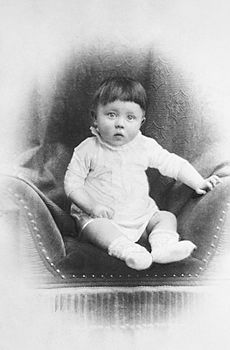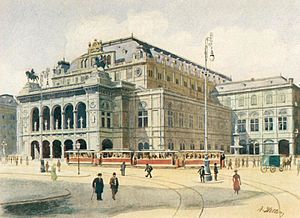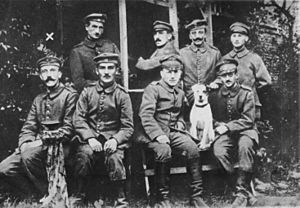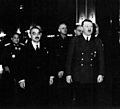Adolf Hitler facts for kids
Quick facts for kids
Adolf Hitler
|
|
|---|---|

Hitler in 1938
|
|
| Führer of Germany | |
| In office August 2, 1934 – April 30, 1945 |
|
| Preceded by | Paul von Hindenburg (President) |
| Succeeded by | Karl Dönitz (President) |
| Chancellor of Germany | |
| In office January 30, 1933 – April 30, 1945 |
|
| President | Paul von Hindenburg (1933–1934) |
| Deputy | Franz von Papen (1933–1934) Hermann Göring (1941–1945) |
| Preceded by | Kurt von Schleicher |
| Succeeded by | Joseph Goebbels |
| Führer of the Nazi Party | |
| In office July 29, 1921 – April 30, 1945 |
|
| Deputy | Rudolf Hess (1933–1941) |
| Preceded by | Anton Drexler (Chairman) |
| Succeeded by | Martin Bormann (Party Minister) |
| Personal details | |
| Born | April 20, 1889 Braunau am Inn, Austria-Hungary |
| Died | April 30, 1945 (aged 56) Berlin, Nazi Germany |
| Cause of death | Suicide by gunshot |
| Citizenship |
|
| Political party | Nazi Party (1921–1945) |
| Other political affiliations |
German Workers' Party (1919–20) |
| Spouse | |
| Parents |
|
| Relatives | Hitler family |
| Cabinet | Hitler cabinet |
| Signature | |
| Military service | |
| Allegiance | German Empire |
| Branch |
|
| Service years | 1914–1920 |
| Rank | Gefreiter |
| Unit | 16th Bavarian Reserve Regiment |
| Wars | World War I |
| Awards |
|
Adolf Hitler (born April 20, 1889 – died April 30, 1945) was a German politician. He became the leader of Nazi Germany. In 1933, he became the Chancellor of Germany. A year later, in 1934, he became the Führer (leader) of Nazi Germany.
Hitler led the Nazi Party from 1921. Once in power, the Nazis created a dictatorship. This meant Hitler had total control. He banned all other political parties.
In 1939, Hitler ordered the invasion of Poland. This action started World War II. During the war, Hitler was the top commander of the German military. He made all the important decisions. This was part of his "leader principle."
Hitler and the Nazi government were responsible for the deaths of millions of people. This included civilians and prisoners of war. Many soldiers and civilians also died because of the war itself. Nazi forces committed many terrible acts. They killed their opponents or sent them to concentration camps and death camps.
Hitler and his followers targeted and killed Jews and other groups. These groups included Roma people, homosexuals, Slavs, and political opponents. This terrible event is known as the Holocaust. During the Holocaust, the Nazis killed six million Jews and many others.
Hitler shot himself in 1945. This happened as the Soviet Army reached Berlin. He did not want to be captured alive.
Contents
Early Life and Family
Hitler's family came from Waldviertel in Lower Austria. The family name changed several times over the years. It was sometimes Hüttler, Hiedler, Hittler, or Hitler. This name was common in German-speaking parts of Europe in the 1800s.
Childhood and Young Adulthood
Adolf Hitler was born on April 20, 1889. He was the fourth of six children. His birthplace was Braunau am Inn, a small town in Austria-Hungary. It was close to the German border. His parents were Klara Pölzl and Alois Hitler. Because his father moved for work, Hitler lived in several towns. These included Passau, Lambach, and Leonding. He went to different elementary schools.
Hitler's mother, Klara Pölzl, was his father's cousin and third wife. His father died in 1903.
Hitler did not do well in high school. He failed his exams twice in Linz. He left school in 1905. He became interested in the ideas of Professor Leopold Poetsch. These ideas were anti-Jewish and supported the idea of a "Pan-German" movement.
In 1907, Hitler went to Vienna to try to get into art school. He failed the entrance exam. His mother died in December 1907, which made him very sad. Hitler did not like Christianity and also disliked Jewish people.
In 1909, he tried again to study art in Vienna. He failed the entrance exam once more. Hitler later said that he became strongly anti-Jewish in Vienna. This city had a large Jewish community.
In 1913, when he was 24, Hitler left Austria for Germany. All young Austrian men had to join the army. Hitler did not like the Austrian army. He moved to the German city of Munich.
Hitler's Paintings
Adolf Hitler was also a painter. He created hundreds of artworks. He sold his paintings and postcards to make money when he lived in Vienna (1908–1913). Even though he was not very successful as an artist, he kept painting throughout his life.
Some of his paintings were found after World War II. They have been sold at auctions for a lot of money. Other paintings were taken by the United States Army. They are still kept by the US government.
World War I Service
On August 16, 1914, Hitler joined the Bavarian army. He fought for Germany in World War I. Hitler served in Belgium and France. He was part of the 16th Bavarian Reserve Regiment. He spent almost all his time on the Western Front.
Hitler worked as a runner. This was a very dangerous job. He ran between different army positions to deliver messages. On November 1, 1914, Hitler became a Gefreiter. This rank was similar to a Private First Class in the US Army. He received the Iron Cross Second Class award on December 2, 1914.
On October 5, 1916, Hitler was hurt by a bullet shell. He stayed in a military hospital until December 1. In March 1917, he returned to the front lines. He fought in a battle and received another award. This was the Militärverdienstkreuz Third Class with swords.
In March 1918, Hitler took part in the Spring Offensive. On August 4, 1918, he received the Iron Cross First Class. A Jewish officer named Hugo Gutmann gave him this award. When Germany surrendered in November 1918, Hitler was shocked. The German army still held enemy territory at that time.
Entry into Politics
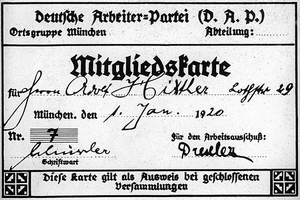
After World War I, Hitler stayed in the army. He went back to Munich. In 1919, he attended a training program. This program was for people who would give speeches to spread ideas.
Later that year, Hitler joined a small political party. It was called the German Workers' Party. He was member number 555. He quickly gained the support of the party's members. Two years later, he became the party's leader. He changed the party's name to the National Socialist German Workers Party. It became known as the Nazi Party.
During the Weimar Republic
In 1923, Hitler gathered hundreds of Nazi Party members. They tried to take over the government. This event was called the Beer Hall Putsch. The attempt failed. The government killed 13 of his men. They also put Hitler in Landsberg Prison. He was supposed to stay for five years, but they let him out after nine months.
Mein Kampf
While Hitler was in prison, he wrote a book. His friend Rudolf Hess helped him. At first, Hitler wanted to call the book Four and a Half Years of Struggle against Lies, Stupidity and Cowardice. But in the end, he named it "Mein Kampf." This means "My Struggle."
Mein Kampf explained some of Hitler's main ideas:
- His belief that life is a battle: He got this idea from Social Darwinism. This was influenced by Charles Darwin's ideas about evolution.
- His idea that the "Aryan race" was better than all other people: This came from a book called The Inequality of the Human Races.
- His plans for an empire in Eastern Europe: These plans were based on how Germany had taken farmland in World War I.
- The idea that Jewish people and communism were linked: He got this idea from a Nazi writer named Alfred Rosenberg.
Start of the Dictatorship
In 1933, Hitler was elected into the German government. He quickly ended freedom of speech. He put his enemies in jail or had them killed. He allowed only the Nazi Party to exist.
Hitler and his propaganda minister, Joseph Goebbels, spread extreme nationalism in Germany. All media had to praise the Nazis. Hitler wanted more people of the "master race" (those he called "Aryans"). He turned Germany into a totalitarian Nazi state.
World War II and The Holocaust
Hitler is seen as the person who started World War II. He ordered the German Army to invade Poland. His army then took over Poland and most of Europe. This included France and a large part of the Soviet Union.
During the war, Hitler ordered the Nazis to kill many people. This included women and children. The Nazis killed about six million Jews in The Holocaust. They also killed Roma, homosexuals, Slavs (like Russians and Poles), and his political opponents.
Eventually, other countries worked together to defeat Germany. Hitler lost all the land he had taken. Millions of Germans died in the war. At the end of World War II, Hitler allowed people in his bunker to leave. Many people left for the region of Berchtesgaden. They used planes and truck convoys.
Hitler, the Goebbels family, Martin Bormann, Eva Braun, and some other staff stayed in the bunker. Hitler married Eva Braun on April 29, 1945.
Death
Less than 24 hours after marrying Eva Braun in Berlin, both Hitler and Eva Braun used poison to kill themselves. Hitler also shot himself with his gun. Before this, Hitler ordered that their bodies be burned. He did not want to be captured alive by the Red Army soldiers who were getting close to him.
Important Facts About Adolf Hitler
- Adolf Hitler was born in Austria.
- Adolf was not a good student. He failed his high school exams twice.
- After leaving school, Adolf became interested in the teachings of Professor Leopold Poetsch. These teachings said that any race except the German race was less important.
- Hitler was also a painter. He created hundreds of artworks throughout his life.
- Hitler would never take off his coat in public, even if it was hot.
- Adolf Hitler fought for Germany as a soldier during World War I.
- After the War, Hitler joined a small political party called the German Workers' Party. It was later renamed the Nazi Party.
- Hitler was put in prison for nine months. This was for trying to take over the government.
- While in prison, Hitler and his friend Rudolf Hess wrote Mein Kampf, which means "My Struggle."
- In 1933, Hitler was elected into the German government. He ended freedom of speech and severely punished or killed anyone who disagreed with him.
- Hitler is known for starting World War II. He ordered the German Army to invade Poland.
- During World War II, Hitler ordered the Nazis to kill millions of people.
- Over six million Jews were killed in The Holocaust.
- Hitler also had Roma (Gypsies), homosexuals, Slavs, and his political opponents killed.
- Hitler lost all the lands he had conquered. This happened when the Allies, a group of other countries, defeated Germany.
- When Hitler knew he had lost, he hid in a bunker. He married Eva Braun. Less than 24 hours later, they both used poison to kill themselves. Hitler also shot himself with his gun so they could not be captured.
Related Pages
Images for kids
-
The house in Leonding, Austria where Hitler spent his early teenage years (photo taken in July 2012)
-
Hitler, at the window of the Reich Chancellery, receives cheers on the evening he became chancellor, 30 January 1933.
-
Hitler and Paul von Hindenburg on the Day of Potsdam, 21 March 1933
-
In 1934, Hitler became Germany's head of state with the title of Führer und Reichskanzler (leader and chancellor of the Reich).
-
Ceremony honoring the dead at the Nazi party rally grounds, Nuremberg, September 1934
-
Benito Mussolini with Hitler on 25 October 1936, when the alliance between Italy and Germany was announced
-
Hitler and the Japanese foreign minister, Yōsuke Matsuoka, at a meeting in Berlin in March 1941. In the background is Joachim von Ribbentrop.
-
October 1938: Hitler is driven through the crowd in Cheb (German: Eger), in the Sudetenland.
-
Hitler reviews troops during the campaign against Poland (September 1939).
-
Hitler visits Paris with architect Albert Speer (left) and sculptor Arno Breker (right), 23 June 1940.
-
The destroyed map room at the Wolf's Lair, Hitler's eastern command post, after the 20 July plot
-
Hitler in 1942 with his long-time partner Eva Braun
See Also
 In Spanish: Adolf Hitler para niños
In Spanish: Adolf Hitler para niños


